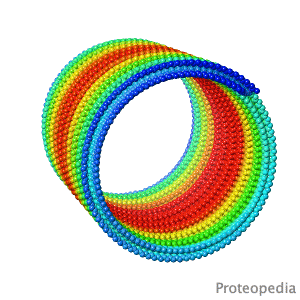Proteopedia:Featured SEL/9
From Proteopedia
(Difference between revisions)
(New page: <table> <tr><td> <imagemap> Image:Featured-gas-vesicle-7r1c.gif|center default https://proteopedia.org/w/FirstGlance/Virus_Capsids_and_Other_Large_Assemblies#Bacterial_Gas_Vesicle </im...) |
|||
| (3 intermediate revisions not shown.) | |||
| Line 3: | Line 3: | ||
<imagemap> | <imagemap> | ||
Image:Featured-gas-vesicle-7r1c.gif|center | Image:Featured-gas-vesicle-7r1c.gif|center | ||
| - | default [[ | + | default [[FirstGlance/Virus_Capsids_and_Other_Large_Assemblies#Bacterial_Gas_Vesicle]] |
</imagemap> | </imagemap> | ||
</td></tr> | </td></tr> | ||
| Line 9: | Line 9: | ||
''ST Huber, D Terwiel, WH Evers, D Maresca, AJ Jakobi''. Preprint 2022 doi: [https://doi.org/10.1101/2022.05.08.489936 10.1101/2022.05.08.489936]<br>Many kinds of bacteria and archaea control their buoyancy to move to optimal positions in liquid environments. They do this by making nano-compartments called "gas vesicles", long "pipes" with closed ends filled with gases. In 2022, gas vesicle structure was solved, revealing self-assembling thin-walled cylinders of remarkable strength with gas-permeable pores and water-repelling (hydrophobic) interiors. Building on this structural knowledge, gas vesicles are being engineered to serve as biosensors that report via ultrasound. | ''ST Huber, D Terwiel, WH Evers, D Maresca, AJ Jakobi''. Preprint 2022 doi: [https://doi.org/10.1101/2022.05.08.489936 10.1101/2022.05.08.489936]<br>Many kinds of bacteria and archaea control their buoyancy to move to optimal positions in liquid environments. They do this by making nano-compartments called "gas vesicles", long "pipes" with closed ends filled with gases. In 2022, gas vesicle structure was solved, revealing self-assembling thin-walled cylinders of remarkable strength with gas-permeable pores and water-repelling (hydrophobic) interiors. Building on this structural knowledge, gas vesicles are being engineered to serve as biosensors that report via ultrasound. | ||
| - | >>> [[Virus_Capsids_and_Other_Large_Assemblies#Bacterial_Gas_Vesicle|Visit I3DC Interactive Visualizations]] >>> | + | >>> [[FirstGlance/Virus_Capsids_and_Other_Large_Assemblies#Bacterial_Gas_Vesicle|Visit I3DC Interactive Visualizations]] >>> |
</div> | </div> | ||
</td></tr> | </td></tr> | ||
</table> | </table> | ||
| - | [[Category:Featured in | + | [[Category:Featured in Selected Pages]] |
Current revision
Bacteria float with nano-balloons.
ST Huber, D Terwiel, WH Evers, D Maresca, AJ Jakobi. Preprint 2022 doi: 10.1101/2022.05.08.489936 |


